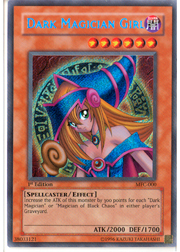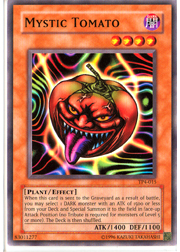Today we’ll be looking at a fairly large category of decks: those that are built around a specific type of monster. These decks focus on the special interactions between cards of a similar type, and, like the swarm/overextension decks we examined last week, they depend upon the ability of the similarly-typed monsters to work together. As you read through this lesson, you will probably see many types of monsters that you recognize. Take special note of the decks that feature monsters and other cards that you currently own, with an eye on building and practicing with a similar deck. There are a lot of deck themes that fall into this category, so prepare for a lengthy read!
 Spellcaster Decks
Spellcaster Decks
Let’s start by looking at Spellcaster decks, which have been made even more popular with the release of Magician’s Force. A Spellcaster deck uses Skilled Dark Magician’s effect to get Dark Magicians out as quickly as possible, rather than building up tributes. In keeping with the type, Spellcaster decks will also often use Dark Magician Girl and Dark Magician of Chaos. Apprentice Magician may also be utilized in order to get spell counters on Skilled Dark Magicians, as well as to search for and special summon Magician of Faith or Old Vindictive Magician.
Spell and Trap Cards
Core spell and trap cards
Dedication through Light and Darkness
Yami
Dark Magic Attack
Monster Cards
Skilled Dark Magician
Dark Magician
Dark Magician Girl
Dark Magician of Chaos
Apprentice Magician
Old Vindictive Magician
Magician of Faith
Witch of the Black Forest
Sangan
Chaos Decks
Invasion of Chaos made our next type of deck incredibly popular, and has made Chaos Emperor Dragon one of the most hotly pursued secret rares in quite some time. Chaos decks focus on using Chaos Emperor Dragon - Envoy of the End and Black Luster Soldier - Envoy of the Beginning. The immediate goal is to set up a strong enough board presence to hold off your opponent by using field-clogging recursive monsters like Mystic Tomato and Shining Angel. These cards thin your deck and protect your life points while you try to draw the unsearchable Dragon and Soldier. Once they hit the field, either of these monsters can be used to kill off your opponent. The Dragon can also be used to destroy everything or pull Yata-Garasu for game. The following cards will be seen in a Chaos type deck, with some variations of course.
Spell and Trap Cards
Core spell and trap cards
Painful Choice
The Warrior Returning Alive
Mirage of Nightmare
Cheerful Coffin
Monster Cards
Chaos Emperor Dragon - Envoy of the End
Black Luster Soldier - Envoy of the Beginning
D. D. Warrior Lady
Mystic Tomato
Shining Angel
Thunder Dragon
Breaker the Magical Warrior
Witch of the Black Forest
Sangan
Yata-Garasu
Sinister Serpent
Tribe-Infecting Virus
Jinzo
 Magical Scientist Decks
Magical Scientist Decks
Moving on from massive Chaos envoys, let’s look at our next deck type, whose seemingly-weak themed monster can really take control of the game—Magical Scientist decks. These decks use Scientist, Catapult Turtle, and Cannon Soldier to win as quickly as possible. How quickly? If a duelist draws two Last Wills and one Cannon Soldier, and goes first, the win is more or less instantaneous. The idea is to get Catapult Turtle and Scientist out, and then combine their effects to launch a barrage of damage to your opponent’s life points from tribute monsters. Last Will provides extra summons for the lock, as well as extra fodder to tribute for damage. Nimble Momonga and Mystic Tomato help maintain board presence, in addition to giving life point boosts and access to other monsters needed for the combo. Mother Grizzly is sometimes used to special summon Catapult Turtle. Additionally, Ceasefire is often used to cause extra damage, or to make up for loss of life points if a duelist has taken damage in the early game and can’t afford to pay for the effect.
Magicial Scientist decks are usually exactly 40 cards, since there is not a lot of wiggle room. The combo needs to be pulled off as quickly as possible, so every card in the deck focuses on getting out that combo. If a well built Magical Scientist deck isn’t stopped as soon as possible, it can be very difficult to beat. You’ll see most of the following cards in Magical Scientist type decks, with some variation:
Spell and Trap Cards
Core spell and trap cards
Call of the Haunted
Ceasefire
Book of Moon
Reasoning
Monster Cards
Magical Scientist
Catapult Turtle
Cannon Soldier
Punished Eagle
Empress Judge
Dark Flare Knight
Roaring Ocean Snake
The regular Magical Scientist utility Fusions
Balter
Ryu Senshi
Dark Flare Knight
Thousand Eyes Restrict
Gilasaurus
Nimble Momonga
Witch of the Black Forest
Sangan
Mystic Tomato
Mother Grizzly
Dragon Decks
Our fourth type is Dragon decks, which saw a boost from Legacy of Darkness. The Dragon type deck focuses on two things: the big push from a Lord of Darkness/Flute of Summoning Dragon/big tribute Dragons combo, and heavy recursion to get large two-tribute Dragons into play without having to tribute. Luster Dragon #2 and Spear Dragon are level 4, 1900 ATK monsters that have also given a boost to this deck type. The following is a list of cards you are likely to see and use in a Dragon type deck:
Spell and Trap Cards
Core spell and trap cards
Flute of Summoning Dragon
Call of the Haunted
Premature Burial
Card Destruction
Monster Cards
Blue-Eyes White Dragon
Lord of Darkness
Luster Dragon #2
Spear Dragon
Tyrant Dragon
The Dragon Dwelling in the Cave
Troop Dragon
Tri-Horned Dragon
Twin Headed Behemoth
Gray Wing
Witch of the Black Forest
Sangan
 Plant Decks
Plant Decks
Moving away from big carnivorous dragons, let’s spend some time examining a more tranquil type: Plant decks. These decks aren't commonly played, but the release of Ancient Sanctuary will bring some new cards to the pool that will make them more playable. The main Plant cards are Mystic Tomato and Fairy King Truesdale. Fairy King Truesdale gives a 500 point boost to all your Plant-type monsters, as long as they are face-up on the field. Des Dendle and Vampire Orchis can also be used to churn out Plant monster tokens. Giant Rat can also be helpful, since most of the useful Plants are Earth types and inflict less than 1500 damage. Additionally, Rainbow Flower can be useful for its ability to attack directly with various bonuses. Here are a few cards you are likely to see and use in a Plant type deck:
Spell and Trap Cards
Core spell and trap cards
Monster Cards
Mystic Tomato
Fairy King Truesdale
Des Dendle
Vampire Orchis
Giant Rat
Rainbow Flower
Lord Poison
Arcane Archer of the Forest
Fairy Decks
Plant decks segue nicely into the next theme—Fairy decks. This deck type has typically been underplayed, mainly because it tends to be weak in the early game—a giant obstacle to overcome when trying to win. However, Ancient Sanctuary will provide several new cards that will help out Fairy type decks. The current Fairy linchpin card is Mudora, a level 4, 1500 ATK monster that increases by 200 ATK for every Fairy card in your graveyard. It's common to see the deck run with multiples of Airknight Parshath and a lot of recursion to get them into play and gain card advantage. Manju of the Ten Thousand Hands is sometimes used if the deck is also using Shinato, King of a Higher Plane. The following cards are generally seen in Fairy type decks:
Spell and Trap Cards
Core spell and trap cards
Painful Choice
Solar Ray
The Sanctuary in the Sky
Monster Cards
Hysteric Fairy
Shining Angel
Mudora
Soul of Purity and Light
The Forgiving Maiden
Kelbeck
Airknight Parshath
Manju of the Ten Thousand Hands
Shinato, King of a Higher Plane
Witch of the Black Forest
Sangan

Fiend Decks
And lastly, for an about face, let’s switch from Fairies to Fiends. Fiend type decks focus on fast and brutal offense, using Kuriboh and gutsy overextensions with Fiend monsters to quickly get one or more Dark Necrofears into play. Recursion is prioritized to continually reuse Dark Necrofear. Dimension Fusion can be used as well, to return to play the Fiends that were removed to summon Dark Necrofear. The following is a list of cards essential to building a winning Fiend type deck:
Spell or Trap Cards
Core spell and trap cards
Dimension Fusion
Nobleman of Crossout
Monster Cards
Dark Necrofear
Giant Orc
Archfiend Soldier
Summoned Skull
Great Maju Garzett
Opticlops
Sangan
Yata-Garasu
Wall of Illusion
Kuriboh
This lesson has been an overview of some of the most commonly seen decks of this type. I haven’t covered them all by any means, as there are still other types of monsters, and so forth. Likewise, duelists are likely to create variations on the above featured decks to compete in their specific regions of play. I encourage all duelists to take a look through their collections and see if the have any cards needed to construct a Type-based deck. Try a few different Type decks and see how the cards work together. Compare how they perform against the Beatdown and Control decks you tried a few weeks back, or the Swarm type deck you tried last week. Getting a feel for how different strategies change the focus of your game will help make you a faster, more intuitive player. In next week’s lesson, we’ll extend our studies to a group of deck types that share a common necessity—specific field spell cards. They will have some similarities to the decks I covered here today in that they do tend to use one key monster type that benefits from the field spell cards. Make certain to check in for that article and further your understanding of Yu-Gi-Oh!